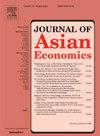新加坡在东盟证券投资中的作用
IF 3.4
3区 经济学
Q1 ECONOMICS
引用次数: 0
摘要
我们利用2007-2017年86个报告国家和241个交易对手国家/地区的双边面板,在重力模型中研究了东盟和经合组织成员国的证券投资对地理距离的弹性。我们发现东盟的弹性比经合组织成员国更负。如果把新加坡排除在外,差距就更大了。这表明新加坡的行为与其他东盟成员国不同。新加坡倾向于在遥远的经合组织国家投资,而其他东盟成员国则倾向于在附近国家投资。我们的研究揭示了区域金融中心在全球金融中的作用。本文章由计算机程序翻译,如有差异,请以英文原文为准。
Singapore’s role for ASEAN’s portfolio investment
We investigate the elasticity of portfolio investment of ASEAN and OECD members to geographical distance in a gravity model utilizing a bilateral panel of 86 reporting and 241 counterparty countries/territories for 2007–2017. We find that the elasticity is more negative for ASEAN than OECD members. The difference is even larger if we exclude Singapore. This indicates that Singapore’s behavior is distinct from other ASEAN members. While Singapore tends to invest in distant OECD countries, other ASEAN members tend to invest in nearby countries. Our study sheds light on the role of a regional financial center in global finance.
求助全文
通过发布文献求助,成功后即可免费获取论文全文。
去求助
来源期刊

Journal of Asian Economics
ECONOMICS-
CiteScore
4.70
自引率
9.40%
发文量
90
期刊介绍:
The Journal of Asian Economics provides a forum for publication of increasingly growing research in Asian economic studies and a unique forum for continental Asian economic studies with focus on (i) special studies in adaptive innovation paradigms in Asian economic regimes, (ii) studies relative to unique dimensions of Asian economic development paradigm, as they are investigated by researchers, (iii) comparative studies of development paradigms in other developing continents, Latin America and Africa, (iv) the emerging new pattern of comparative advantages between Asian countries and the United States and North America.
 求助内容:
求助内容: 应助结果提醒方式:
应助结果提醒方式:


